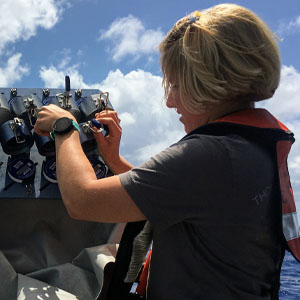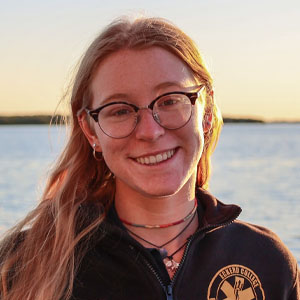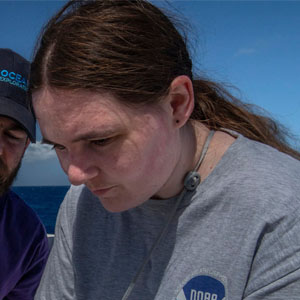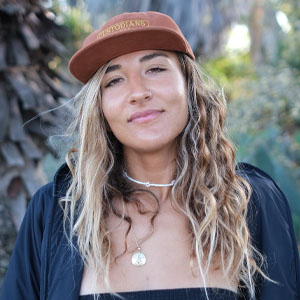National Intern Day 2022
At NOAA Ocean Exploration, engaging the next generation of ocean explorers is at the foundation of our mission. One of the ways we accomplish this is through internship programs. Each group of interns brings unique perspectives and fresh ideas that advance our office’s mission in tangible ways. Get to know this year’s interns below!

Henry Arndt
Explorer-in-Training (Expedition-Based, Hydrography and Seafloor Mapping)
Henry is a recent graduate of the University of Colorado at Boulder, earning a bachelor’s degree in atmospheric and oceanic sciences. He also holds an associate’s of applied sciences degree in GIS and geospatial sciences. He was always interested in ocean mapping and got to experience it firsthand this past March as an Explorer-in-Training with NOAA Ocean Exploration. Henry’s duties included serving as a mapping watchstander on NOAA Ship Okeanos Explorer during the 2022 Caribbean Mapping expedition. Okeanos Explorer mapped an area of approximately 18,000 square kilometers (6,950 square miles) in the region south of Puerto Rico. Henry’s GIS background helped him successfully stand mapping watches. His favorite part of the voyage was learning NOAA’s procedures to operate SONAR display and processing software such as Qimera and Fledermaus. He also took great satisfaction in seeing the web map service that tracks Okeanos Explorer include data that he had worked to collect. Henry is currently in the process of onboarding as an oceanographer with the Naval Oceanographic Office at the John C. Stennis Space Center. He is excited to use the lessons he learned on board Okeanos Explorer in his upcoming career.

Paige Hoel
Explorer-in-Training (Expedition-Based, Hydrography and Seafloor Mapping)
Paige is a third year Ph.D. student at the University of California Los Angeles (UCLA) who has a self-proclaimed obsession with the ocean. She participated in the Explorer-in-Training Program in April of 2022, sailing aboard NOAA Ship Okeanos Explorer for the 2022 Puerto Rico Mapping and Deep-Sea Camera Demonstration, where she assisted with mapping and GIS tasks on board. She continues her work with the office on shore, making GIS products that help detail expedition outcomes. Paige attended the University of California Santa Barbara for her undergraduate work, majoring in physical geography and Earth science. After a short stint at the National Center for Atmospheric Research in Boulder, Colorado, she started her Ph.D. at UCLA. Paige is specifically interested in human impacts on primary production and ecosystem health in the coastal ocean. Her current research explores the impacts of anthropogenic sources of nutrients on phytoplankton and kelp populations in Southern California. Beyond research, Paige is passionate about scientific communication and outreach. While interning with NOAA Ocean Exploration, Paige believes the greatest part of the experience was fostering friendship while at sea. She says, “there's no group of people I would have rather shared that crazy and wonderful month with. Those 6 a.m. sunrises with my shift partner are a memory I will have forever.” Paige will carry this enthusiasm for ocean exploration into the remainder of her Ph.D., where she hopes to deepen her connections with the office and strengthen her scientific communication skills.

Isabel Moyer
Hollings Scholar
Isabel is a rising senior at Eckerd College, where she is double majoring in marine science (with a focus in biology) and animal studies. This summer, she is working with NOAA Ocean Exploration as a Hollings Scholar, interning with Dr. Adrienne Copeland and Katharine Egan. Currently, Isabel is studying midwater faunal distribution in the Marianas Trench, using footage from the 2016 Deepwater Exploration of the Marianas expedition. This expedition included some of the first midwater exploration ever done in the Mariana region, and Isabel’s analysis could unlock key insights about this unique environment. In the course of her research, Isabel has become familiar with a variety of data management techniques, such as annotating footage in SeaTube, cleaning and analyzing acoustic data in Echoview, and conducting statistical tests in R. She was also part of the shore-based science team during the Voyage to the Ridge 2022 expedition, where she participated via telepresence in midwater remotely operated vehicle dives on the Mid-Atlantic Ridge. Isabel remarks, “My favorite part of my NOAA Ocean Exploration experience so far has been becoming part of the close community of midwater scientists who are dedicated to exploring the world’s largest biome. I’ve also enjoyed becoming more familiar with some of the organisms we see often and learning about how studying the midwater is crucial to understanding the interconnected nature of the entire ocean.” Isabel would like to thank everyone who has taken the time to meet with her and give career or research advice and hopes to return to work in NOAA after graduate school.

James Kot
Department of Defense SkillBridge Intern
James is a retiring military veteran from the U.S. Air Force working with NOAA Ocean Exploration under the Department of Defense Skillbridge Program. After serving 20 years, he has found a new passion with the office’s grants management team in the Science and Technology division. Growing up in upstate New York, James was surrounded by rivers, lakes, and estuaries that were out of reach for recreational activities due to pollutants. Instead, people had to travel even farther north to become connected to the environment. Now, one door is closing and another is opening. While serving, James acquired many experiences and completed his Master of Business Administration degree. He is reconnecting to the environment through NOAA. James’ experience through various job pathways has opened the door to an exciting and challenging intern position as a grants analyst. While he enjoys the outdoors of Alaska year-round, for travel, hiking, fishing, and many other activities, he now brings that personal and professional energy to this organization.

Margaret Hanley
Explorer-in-Training (Expedition-Based, Hydrography and Seafloor Mapping)
Margaret is a rising senior at the College of Charleston and a current member of the school’s BEnthic Acoustic Mapping (BEAMS) program. Under the guidance of Dr. Leslie Sautter, she conducted research characterizing and classifying deep-sea coral mounds on the North-Central Blake Plateau. Her work pulled from bathymetric data collected by NOAA Ocean Exploration via NOAA Ship Okeanos Explorer during Windows to the Deep 2019: Exploration of the Deep-sea Habitats of the Southeastern United States. This allowed her to better understand how underlying topography can impact coral growth. After utilizing data from the Okeanos Explorer in her research, Margaret was able to sail on the ship as a science team member. While an Explorer-in-Training with NOAA Ocean Exploration, Margaret worked on the first Voyage to the Ridge 2022 expedition to assist in mapping the Charlie-Gibbs Fracture Zone to apply mapping data to select future dive sites. While there, she saw firsthand how much work goes into gathering data and making it presentable to the public. Learning to work with data at all levels, from acquisition to final research products, further confirmed her love for seafloor mapping and fueled her desire to pursue the field through higher education. Upon graduating in December with a degree in geology, Margaret will immediately pursue her master’s in marine science at the University of South Florida (USF). There, as a member of the Center for Ocean Mapping and Innovative Technologies at USF, she will participate in and contribute to more mapping projects along the Florida coast.

Gabriel Hernandez
Explorer-in-Training (Expedition-Based, Hydrography and Seafloor Mapping)
Gabriel earned his bachelor's in environmental geosciences and is currently a graduate student at Mississippi State University pursuing his master's in the same field. As an Explorer-in-Training on the first Voyage to the Ridge 2022 expedition with NOAA Ocean Exploration, Gabriel got to experience the ins and outs of ocean exploration firsthand. He learned what it's like to collect and process data that will be used to advance our knowledge of deep-sea processes. Gabriel's thesis work employs data collected on various cruises conducted by the Okeanos Explorer between 2011 and 2019, where he looks at seafloor morphology and how it relates to methane seep emergence on the United States Atlantic Margin. Additionally, Gabriel is currently funded by NOAA to work on a research project at Mississippi State University to automate seep detection in multibeam sonar scans. The skills he learned while working with NOAA have inspired him to continue acquiring experience in the field, so that he can further contribute to humanity's body of knowledge of the natural world. Gabriel says, "I'm incredibly grateful for the opportunities I've had to work with NOAA so far. I've been able to meet and learn from experts in the field who inspire me to be the best I can be as a student and an aspiring scientist. I don't think I could have had a better experience than I had with the Voyage to the Ridge 2022 team. They are awesome and capable people who drive students like me to be the best that we can be."

Kathrin Bayer
Explorer-in-Training (Expedition-Based, Hydrography and Seafloor Mapping)
Kathrin is a recent graduate of the University of California Santa Cruz where she completed her master's degree in ocean sciences. She participated in the 2022 Caribbean Mapping expedition aboard NOAA Ship Okeanos Explorer as an Explorer-in-Training. She is interested in deep-ocean exploration and was thrilled to be able to participate in this exciting opportunity. During the expedition, she monitored data as it was being collected; cleaned and processed the collected water column, seafloor, and sub-bottom data; and launched expendable bathythermographs. She used Qimera, Fledermaus,and FMGT in order to convert the raw data into finished products, such as maps, that provided information on what the seafloor south of Puerto Rico looks like. She was most excited to learn new data collection techniques and to experience what life is like during a scientific expedition.

Madelin Jimenez-Andersen
Explorer-in-Training (Shore-Based, Exploration Education, Media, and Science Communication)
Madelin Jimenez-Andersen is a current master’s student in marine biology at Scripps Institution of Oceanography at University of California San Diego. Madelin first became interested in science communication and education during graduate school, where she held multiple teaching positions and a communication fellowship. This led her down a path of writing and video production where she found a passion for creating educational content. Madelin’s goal is to use the power of media and exploration in order to communicate science and conservation efforts across our oceans. Her project goals include working with the NOAA Ocean Exploration education team to create videos that can be used by educators and the general public alike. Her project focuses on editing and combining the extraordinary content collected by NOAA Ocean Exploration via NOAA Ship Okeanos Explorer and interviews with deep-sea scientists that have been conducted by the office. Madelin is interested in creating media that can reach broad audiences while sharing her passion for ocean science.
Published July 28, 2022